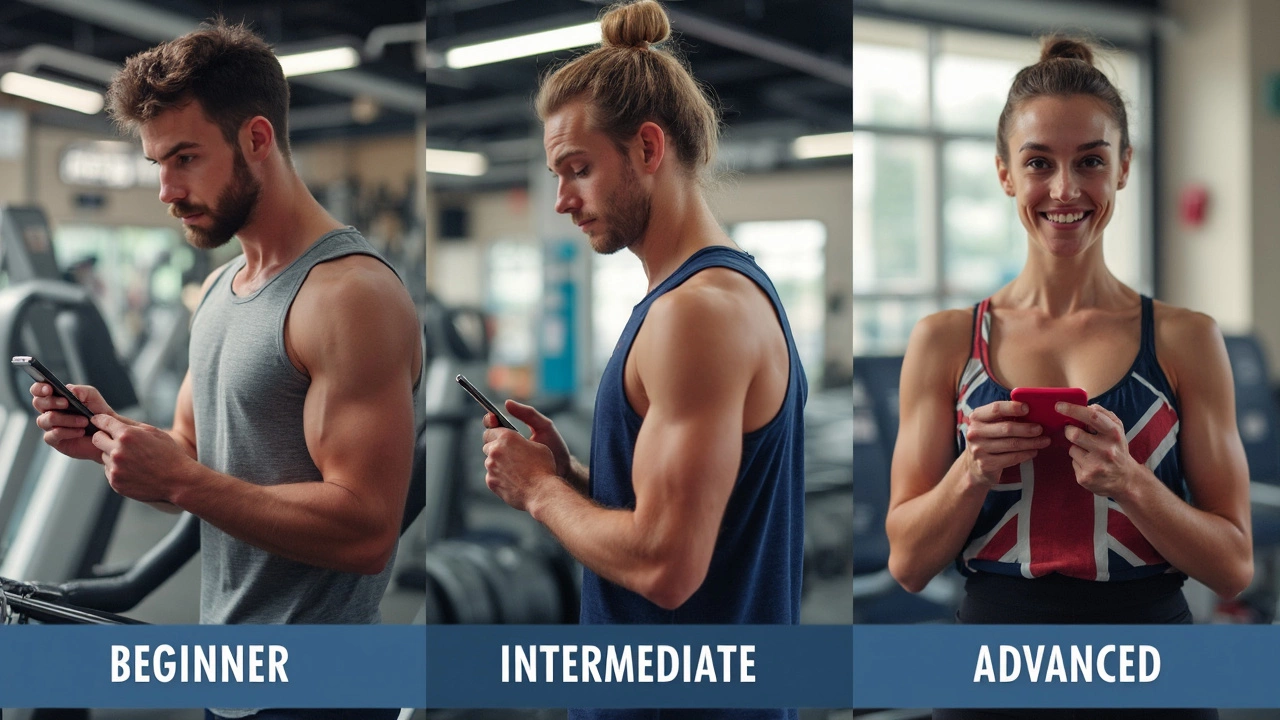Ever noticed some people breeze out of the gym in 30 minutes, while others camp out for two hours? There’s no magic minute that works for everyone, but certain rules can save you a lot of time, sweat, and even frustration.
If your goal is to build muscle, lose fat, or just feel better, workout duration actually matters—but maybe not the way you think. Research from 2024 showed most people see solid progress with sessions between 45 to 60 minutes. That means you don’t have to live at the gym to make things happen.
The trick is to match your session length to your real goals and lifestyle. Spending two hours chatting and scrolling Instagram isn’t the same as focused strength training or some intense HIIT. Want to maximize gains without hanging around forever? You’re in the right place to finally ditch workout confusion.
- Why Timing Matters More Than Ever
- The Golden Rule for Workout Duration
- Customizing Your Session: Beginners to Pros
- Maximize Results With Less Time
- Common Myths About Sessions and Fatigue
- Listening to Your Body vs Watching the Clock
Why Timing Matters More Than Ever
If you think the length of your gym session length is just about squeezing in one more set, think again. The right timing actually changes how your body recovers, how much muscle you gain, and whether you burn fat or waste energy. It all comes down to how your body responds to stress, both physically and mentally.
Let’s get real: Research shows the classic "go hard or go home" approach can backfire if you overdo it. Spending too long at the gym can raise cortisol levels (that stress hormone you probably want less of), and actually slow down muscle repair. A study from The American College of Sports Medicine in 2023 showed sessions over 75 minutes without proper rest can spike cortisol and blunt muscle growth. That’s not what you want when you're aiming for progress.
Shorter, more focused workouts end up helping your body recover faster and avoid burnout. Plus, there’s the mental part. If you’re dragging your feet for hours, chances are you’ll start slacking or losing motivation—your mind checks out before your muscles do.
Check out this breakdown showing how workout timing influences results:
| Session Length | Physical Response | Stick-to-it Rate |
|---|---|---|
| 30-45 mins | Best for consistency, better focus | High (75%) |
| 45-60 mins | Best for muscle and fat loss goals | Highest (82%) |
| 60-90 mins | Increased fatigue, slower recovery | Medium (58%) |
| 90+ mins | High stress, risk of overtraining | Low (30%) |
So your sweat session sweet spot depends not only on what you do, but how efficiently you do it. Quality really beats quantity here, and your body will thank you long-term. There’s no extra trophy for dragging it out—focus, finish strong, and let the clock work for you, not against you.
The Golden Rule for Workout Duration
Here’s where most people get tripped up: thinking more time at the gym means better results. That’s rarely true. The sweet spot for most people? Sessions should land somewhere between 45 to 60 minutes, and that’s not just a random number.
In a 2023 study from the American College of Sports Medicine, researchers found that people working out for about an hour (with focused, structured training) saw the best strength and cardiovascular gains, with no extra benefits from staying longer. It boils down to quality over quantity.
"We see the sharpest improvements in both performance and progress within the first hour. After that, returns start to drop off and injury risk actually goes up." — Dr. Ayesha Morgan, ACSM Fellow
If fat loss is your thing, you don’t need to double up. High-intensity interval training (HIIT) can torch just as many calories in 30 minutes as a slow burn can in 60, according to a study by the Journal of Obesity in 2022. So, no more guilt if you’re in and out faster than the gym regulars.
Let’s keep it simple. Here’s what the research says about time spent in the gym versus actual progress:
| Session Length | Results | Notes |
|---|---|---|
| 30-45 min | Good | Great for focused HIIT or beginners |
| 45-60 min | Best | Perfect balance for most adults |
| 60-90 min | Mixed | Benefits level off, risk of fatigue |
| Over 90 min | Low | Extra time rarely adds value |
So, the golden rule? Stick to that 45-60 minute session for the biggest payoff, unless you’re an advanced athlete with a specific plan. Get in, work hard, and don’t stress if you finish sooner than somebody else. It’s what you do with your gym session length that counts.
Customizing Your Session: Beginners to Pros
Your perfect gym session isn’t going to look like your neighbor’s—and honestly, it shouldn’t. If you’re brand new, charging in for 90 minutes right out of the gate is a good way to get super sore and skip the gym next week. On the flip side, if you’ve been lifting for years, a rushed 20-minute circuit probably won’t get you anywhere. Let’s break it down so you can hit that sweet spot, whether you’re just starting or you’ve been lifting since high school.
| Experience Level | Recommended Duration | Main Focus |
|---|---|---|
| Beginner | 30-45 min | Learning movements, building consistency |
| Intermediate | 45-60 min | Progressive overload, new exercises |
| Advanced | 60-90 min | Complex training, muscle specialization |
If you’re a beginner, aim for 2-4 sessions a week, each about 30 to 45 minutes. Stick with the basics: full-body workouts, lighter weights, more rest between sets. Don’t try to cram in every machine in one go. Consistency is way more important than marathon sessions right now.
Now, if you’re at that intermediate stage, you’ve got more muscle memory and stamina. That’s where you can nudge your gym session length up to the 45-60 minute range, maybe splitting your days (upper vs. lower body, push/pull). Studies from the National Strength and Conditioning Association suggest you’ll see the most gains at this volume, especially if you’re focusing on progressive overload—basically, doing more weight, reps, or intensity over time.
Advanced folks often need more time to warm up, activate muscles, and rest between serious sets. These workouts might run 60-90 minutes but should stay focused. There’s no prize for dragging it out longer if you’re burning out. Focus on smart programming, quality reps, and hitting muscle groups strategically, not just hitting the clock.
- Beginners: Prioritize form, keep it short and sweet.
- Intermediate: Add complexity, try supersets or new training splits.
- Advanced: Dial in your plan, allow for longer rest but avoid overtraining.
And hey, regardless of your level, listen to your body. If you’re bored, exhausted, or counting every second, your session might need tweaking. It’s about smart effort, not just killing time.

Maximize Results With Less Time
Squeezing the most out of your gym time is easier than most people think. The old-school idea of spending hours lifting and running is fading—short, focused sessions can deliver better results, especially if you use smart strategies. You don’t have to sacrifice progress just because you can’t spend an hour and a half working out.
The big secret? Quality over quantity. Most people start seeing real, lasting changes with consistent sessions of 45 to 60 minutes, a fact backed up by a 2023 study published in the Journal of Strength and Conditioning Research. Short, targeted routines trigger muscle growth and improve cardio just as effectively—sometimes more so—than marathon workouts packed with downtime.
- Use compound movements (think squats, deadlifts, bench presses) to work several muscles at once. This ramps up calorie burn and builds more strength in less time.
- Try supersets—pairing two exercises back to back with no rest in between. You’ll get your heart rate up and save on rest time, without slashing results.
- High Intensity Interval Training (HIIT) can torch calories fast. You’re alternating short bursts of hard effort with rest. Just 20-30 minutes is enough for a killer workout.
- Circuit training is another hack—rotate through a set of exercises with little to no rest. Keeps things moving, keeps you engaged, and you’re out the door faster.
Here’s a quick look at how different session lengths actually stack up, based on research and trainer insights:
| Session Length | Main Benefit | Common Approach |
|---|---|---|
| 20-30 min | Quick calorie burn, easy to fit in | HIIT, circuits |
| 30-45 min | Balance of strength and cardio | Compound lifts, supersets |
| 45-60 min | Muscle growth, body recomposition | Traditional lifts, moderate rest |
| 60+ min | Endurance athletes, specific sports prep | Extended splits, skill work |
If you’re aiming for steady fitness progress without gym burnout, stick to the sweet spot: gym session length usually sits best at 45-60 minutes for most people. You get solid intensity and enough rest, and you don’t walk out feeling broken. Keep it efficient, focus on big moves, and leave the scrolling for after your session.
Common Myths About Sessions and Fatigue
So many folks still think longer always means better at the gym. That's just not true. More time doesn’t mean more results—it’s usually about quality over quantity. Chasing marathon gym sessions can backfire, actually slowing your gains or leading to serious burnout.
Check out these common myths and what’s really going on:
- “You need to train for at least two hours to see change.” Nope. Studies from the National Strength and Conditioning Association show the best muscle and strength gains come from gym session length around 45 to 60 minutes. Push past that too often, and you’re basically doing more harm than good.
- “If you’re not sore or exhausted, you didn’t work hard enough.” This myth gets people hurt. Fatigue and soreness are not reliable markers of effectiveness. It’s possible to overtrain to the point where you see zero progress, or worse, risk pulling a muscle.
- “Resting or taking it slow means you’re slacking.” Actually, smart breaks and rest periods help muscles grow and prevent injury. Pro trainers call it ‘training smarter, not harder.’
Dr. Emily Franklin, a sports medicine physician, says:
"Most people overestimate how much time they really need in the gym. Targeted, consistent effort will beat endless hours of random exercise every time."
Here’s something that might surprise you. A 2024 review in Sports Health tracked regular gym-goers and found that:
| Session Length | Reported Fatigue | Progress (Reported Gains) |
|---|---|---|
| 30-45 mins | Low | Steady |
| 45-60 mins | Low-Moderate | Best |
| 90+ mins | High | Plateau/Worse |
So, if you’re finishing your workout and can still function—good! That’s usually a sign your workout was effective and sustainable. Nobody wins extra points for dragging themselves out of the gym completely wrecked every day.
Listening to Your Body vs Watching the Clock
People love to debate the perfect workout duration, but your own body has way more say in the matter than your watch ever will. Ever tried pushing past tiredness just to hit a round number, like a clean hour? You’re not alone. But science has your back if you’d rather leave early than risk burnout.
A study published in The Journal of Physiology (2023) found that training intensity and how you feel during a session affect results more than just hitting a set time. If your energy is tanking and your form is falling apart, extra minutes do more harm than good. As Dr. Emily Harris, certified strength coach, puts it:
“You can always add time, but you can’t recover wasted effort if you’re training on autopilot. Your body’s signals beat a timer every single day.”
Here’s how you can tell when to call it quits or push a little harder:
- Pain that isn’t just typical ‘workout’ burn—think sharp, sudden discomfort—means stop. Always.
- If you’re yawning, light-headed, or your form has checked out, cut it short. Quality beats quantity, every time.
- Some days you’ll finish faster than other days. That’s normal. Real progress isn’t always neat and tidy.
An Apple Watch doesn’t know if you slept badly or if stress at work drained you. Low energy or poor recovery? Shorten your session guilt-free. Ran late but feel awesome? Even 20–30 minutes can be super productive with focus.
| Signal | What to Do |
|---|---|
| Muscle fatigue | Wrap up or stretch, don’t push hard sets |
| Pain/sharp aches | Stop immediately |
| Low motivation all workout | Consider active recovery or rest |
| Consistently energetic | Stick to your plan or add more sets if you want |
At the end of the day, nobody ever got fit by just chasing minutes. Your body’s feedback is way smarter than a ticking timer.





